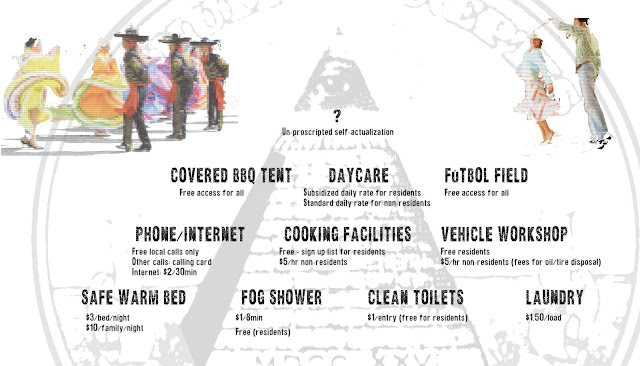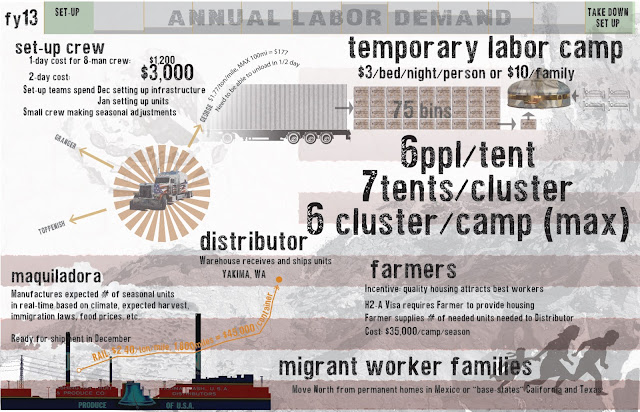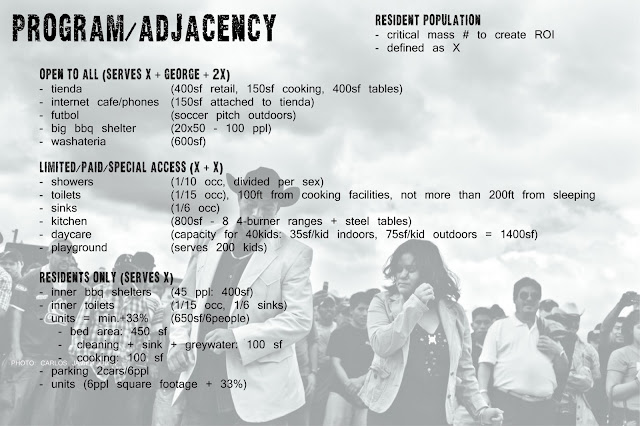 |
EL TROQUE ON DISPLAY
For many of the migrants, the vehicle is the only safe place to invest their money - property is neither feasible nor reliable. The vehicles are often expensive, souped up, and are a social/cultural/economic display of individuality, social status, and wealth. The structures need only integrate these qualities in order to achieve individuality at the unit level. |
 |
| INCENTIVES: it's very important to understand the reasons behind which different stakeholders and actors make their decisions. |
 |
| AFFORDABLE: migrant workers have stated clearly what they desire in housing - safe, clean and affordable. But what exactly does that mean? |
 |
| CLEAN: without an infrastructure grid, their are limitations but also opportunities for different types of sanitation facilities. These OSHA requirements dictate the minimum, but should be exceeded in order to provide a sense of dignity and even luxury. |
 |
| SAFE: scale is important - social theory suggests a limit of effective/safe group size. The camps are designed around traveling/group patterns of migrant workers. |
 |
| HIERARCHY OF NEEDS: the order in which services must be met, and upon which others rest. |
 |
| 3D-PROGRAM ADJACENCY: understanding relationships between different spaces - which need to be PRIVATE, PUBLIC, and SEMI-PRIVATE. Spatial relationships and understandings are developed from this diagram. |
 |
| A World-of-Warcraft-Style migrant camp, complete with spidery alien creatures. |
 |
| UNIT LEVEL: Rainwater captured in the central membrane is transferred to individual units. The units are divided into hexagons, with removable partitions for privacy. These units can be organized around groups of 2-3 single men, or a multi-generational family. |
 |
| VERSIONING: experimenting |
Temporary labor camps often are the most appropriate solution, for the greatest amount of migrant workers. Unfortunately, the paradigm for these camps has mostly been squalor and poor design. Precedents such as Burning Man's Black Rock City, and various luxury safari camps have proven that a vibrant, safe, clean, and desirable place to live can be done with a minimum of material - but careful planning.
The goal is to achieve a camp that is safe and clean, with the dignity and personality of a luxury camp. Affordability will be achieved through a comprehensive business plan, lack of utilities/infrastructure through "off the grid" techniques (inspired by United States Marine Corps
Experimental Forward Operating Bases), and super lightweight structures that reduce shipping, set-up, and maintenance costs.
The next stage of development is experimenting with collapsible, deployable tensile fabric membrane structures. Exciting!
Generally, tensile structures are composed of platonic solids (cubes, polyhedrons, etc) that are uniform. This makes it difficult to enter, as well as its connection to the ground.
The way to work around that is to alter compression and tension member lengths in the hedron, thereby being able to manipulate different members, when, for instance, one wants to create a door or a window - with very different size parameters.
In order to cope with that amount of geometric calculation, this project is using Grasshopper, a parametric design option in Rhino, to develop a voronoi pattern in the structure (Voronoi - where lengths of members are the closest - most optimal - distance between points, thereby maintaining tension and structural integrity).
These patterns are not random: there are very specific and rigorous parameters for breaking down the cellular structure, as mentioned below:




























No comments:
Post a Comment